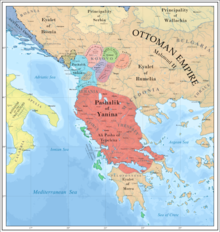Pashalik of Scutari
Pashalik of Scutari Pashallëku i Shkodrës | |||||||||||
|---|---|---|---|---|---|---|---|---|---|---|---|
| 1757–1831 | |||||||||||
Mustafa Sherifi Bushati | |||||||||||
| Historical era | Early modern period | ||||||||||
• Established | 1757 | ||||||||||
• Disestablished | 1831 | ||||||||||
| |||||||||||
The Pashalik of Scutari, Iskodra, or Shkodra (1757–1831), was an
Background
The weakening of
History
The influence of the Bushati was established between 1757 and 1775 by
Mehmed Bushati's son and third successor,

In 1796, the Montenegrin tribes of
When the
The Bushati dynasty's rule came to an end when an Ottoman army under Mehmed Reshid Pasha laid siege to the Rozafa castle at Shkodër in 1831 and forced the surrender of the last pasha Mustafa Bushati who had rebelled against the sultan whom they accused as Kaurr – infidel.[8] This defeat not only ended a planned alliance between the Albanians and the Bosnians, who were similarly seeking autonomy,[8] but also brought about the dissolution of the pashalik.
Aftermath
In 1867, the Sanjak of Scutari merged with the
Pashas
- Mehmed Bushati(1757–1774)
- Mustafa Bushati(1774–1778)
- Kara Mahmud Bushati(1778–1796)
- Ibrahim Bushati(1796–1810)
- Mustafa Sherifi[9](1810-1831)
See also
- Pashalik of Janina
- Albania under Ottoman Empire
- Albanian Pashaliks
- List of Sunni Muslim dynasties
References
- ^ a b c Elsie 2005, p. 65.
- ^ Vickers 1999, p. 18.
- ^ Iseni 2008, p. 120.
- ^ Zickel & Iwaskiw 1994, p. 19.
- ^ a b c Dauti 2018, p. 32.
- ^ Kiel 1990, p. 231.
- ^ Castellan 2002, p. 37: ayant éliminé deux familles rivales
- ^ a b c d e Jazexhi 2002, p. 48.
- ^ Elsie 2012, p. [page needed].
Bibliography
- Bahl, Taru; Syed, M. H. (2003). Encyclopaedia of Muslim World. ]
- Castellan, Georges (2002). Histoire de l'Albanie et des albanais. N.p.: Editions Armeline. ISBN 978-2-910878-20-7.
- Dauti, Daut (30 January 2018). Britain, the Albanian Question and the Demise of the Ottoman Empire 1876-1914 (phd). University of Leeds.
- ISBN 978-1-84511-031-4.
- Elsie, Robert (2012). A Biographical Dictionary of Albanian History. London / New York: I.B. Tauris in association with The Centre of Albanian Studies. ISBN 978-1-78076-431-3.
- Iseni, Bashkim (2008). La question nationale en Europe du Sud-Est: genèse, émergence et développement de l'identité nationale albanaise au Kosovo et en Macédoine. Peter Lang. ISBN 9783039113200. Retrieved 5 March 2013.
- Jazexhi, Olsi (2002). The Albanian Pashalik of Shkodra under Bushatlis 1757 – 1831. Kuala Lumpur: IIUM. Archived from the original on 2015-06-27.
- ISBN 978-0-521-27458-6.
Kiel, Machiel (1990). Ottoman architecture in Albania, 1385-1912. Research Centre for Islamic History, Art and Culture.
- Vickers, Miranda (1999). The Albanians: A Modern History. New York: ISBN 978-1-86064-541-9.
- Zickel, Raymond; Iwaskiw, Walter R. (1994). Albania: A Country Study. GPO for Library of Congress.
